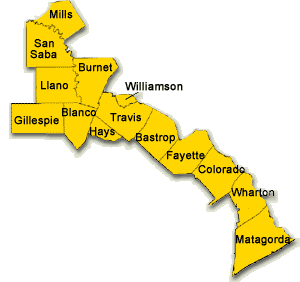|
| Home | | About Us | | Water Planning | |
Groundwater | |
Conservation | |
Environmental Flows | |
Drought Mgmt. | |
Resources | |
Search | | ||
|
Region K - Lower Colorado
2001 Regional Water Plan Overview  Basic Plan Facts
What's at Issue?
The protection of bay and estuary inflows is particularly relevant for Region K due to the importance of the Matagorda Bay estuary to the economy and quality of life of the region. Potential impacts from proposed strategies in the 2001 regional plan to the freshwater inflows to Matagorda Bay could be devastating to the region's wildlife and the coastal economy. These proposed strategies are the result of the increasing pressure that population growth in this region, and in its neighboring region (L), is putting on the limited water supplies of Central Texas.Despite relatively high municipal use rates in the area, the region did not incorporate advanced conservation measures into planning efforts. For example, much of the anticipated shortages for the cities of Dripping Springs, Llano, and Goldthwaite could be resolved if these areas were subject to increased conservation measures. In addition to this, the consumption rate that was used to calculate demands for Austin - the largest municipal water user in the region - was inflated. Because of this, future municipal demands for the region are also inflated, which can lead to an overemphasis on costly and environmentally harmful water projects. There is an emphasis on agricultural conservation measures, especially with rice farming. This is important given that rice farming is the largest user of water in the Lower Colorado River Basin. Unfortunately, the measures do not stand alone, but are tied to the success of a specific proposed strategy - the transport of water from the Colorado River to San Antonio. Action Items
Here are some of the items the Region K Planning Group must address.For conservation and drought management, the plan needs to...
To secure the protection of flows for fish and wildlife, the plan needs to...
To ensure that only the most economically sound water supply strategies are implemented, the plan needs to...
Additional Resources
Analysis
The National Wildlife Federation analyzed the initially prepared plan using their Principles for an Environmentally Sound Regional Water Plan. Please contact us for more information about this analysis.
|
||||||||||||


 Region K
Region K